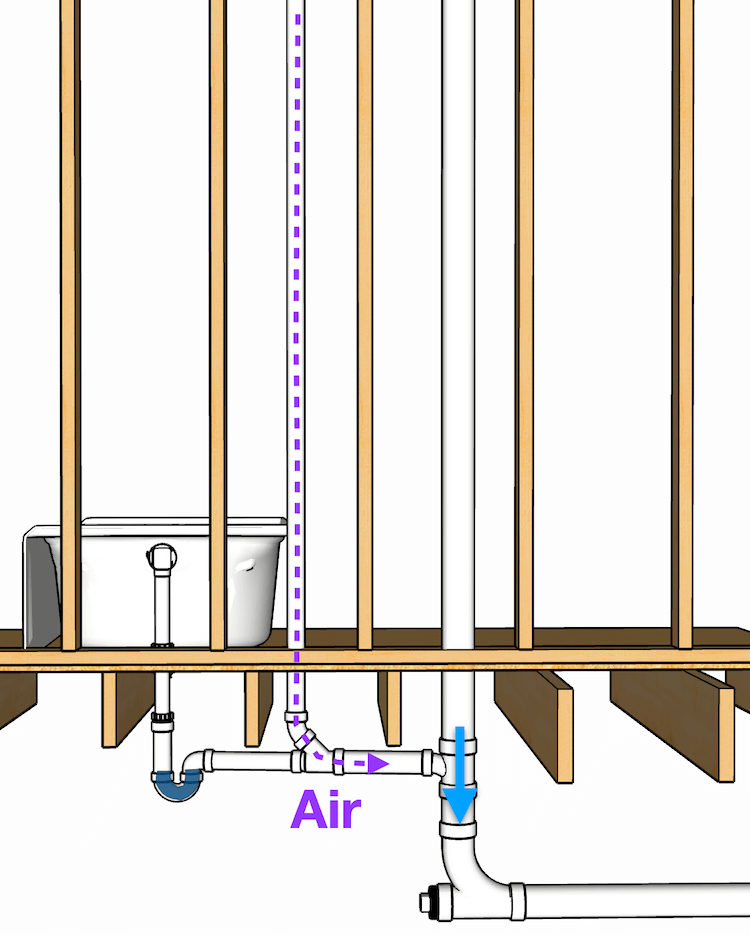Achieving Proper Ventilation in Your Plumbing System: Why
Achieving Proper Ventilation in Your Plumbing System: Why
Blog Article
We have uncovered this great article relating to What Is a Plumbing Vent and Why Is It Important down the page on the web and concluded it made perfect sense to write about it with you in this article.

Proper ventilation in pipes systems is frequently overlooked, yet it is vital for maintaining the capability and safety of your home's pipes. Ventilation helps control atmospheric pressure, prevent the buildup of damaging gases, and make certain the efficient removal of waste. In this overview, we will certainly explore the significance of appropriate pipes ventilation, how it works, and the benefits it gives your pipes system.
Just How Air Flow Functions in Plumbing Systems
Atmospheric Pressure Guideline
Appropriate ventilation keeps well balanced air pressure within the plumbing system. When water streams with pipes, it displaces air. Without sufficient ventilation, this displacement can develop unfavorable pressure, bring about slow drains pipes or siphoning of water from traps, which can trigger unpleasant odors to leak right into the home.
Preventing Drain Gas Buildup
Among one of the most critical functions of plumbing vents is to stop sewer gases, such as methane and hydrogen sulfide, from collecting within the home. These gases can position major wellness dangers and are highly combustible. Vent pipes allow these gases to run away securely outside.
Aiding in Waste Removal
Ventilation assists in the effective elimination of wastewater by stopping airlocks in the drain system. When air can flow openly with the vents, it allows water and waste to move smoothly via the pipelines, decreasing the threat of blockages and back-ups.
Benefits of Correct Ventilation
Enhanced System Effectiveness
Correctly aerated pipes systems operate a lot more efficiently, with fewer obstructions, faster draining, and less pressure on the pipelines. This efficiency prolongs the life expectancy of the pipes system.
Improved Air High Quality
By protecting against drain gases from entering your home, correct ventilation adds to better indoor air quality, making your living atmosphere healthier and more comfy.
Stopping Water Damage
Appropriate ventilation assists protect against water from being siphoned out of catches, which can cause drain gases going into the home and triggering water damage over time.
Actions to Make Sure Appropriate Ventilation
Consulting Pipes Codes
Always seek advice from regional pipes codes when creating or modifying your pipes system. These codes offer the necessary standards for proper airing vent and ensure your system satisfies safety requirements.
Regular Assessment and Maintenance
Routine examinations can help recognize possible ventilation problems prior to they become major troubles. Maintenance jobs, such as cleansing vent pipes and looking for blockages, are necessary for maintaining the system in good working order.
Expert Installation
For brand-new installations or significant modifications, it's a good idea to hire a specialist plumber. They have the proficiency to make certain the ventilation system is appropriately created and installed according to code.
Comprehending Air Flow in Plumbing
Air flow in plumbing refers to the network of pipelines that allow air to stream via the drainage system. These vents offer numerous purposes, including managing atmospheric pressure within the pipes, stopping sewage system gases from entering the home, and assisting in the smooth flow of wastewater.
Kinds Of Pipes Vents
Key Stack Vent
The primary pile air vent, also known as the air vent pile, is the primary vent in a plumbing system. It extends from the primary drain align with the roofing system, permitting gases to escape and fresh air to get in the system.
Branch Vent
Branch vents connect to the main stack air vent and offer private fixtures, such as sinks, bathrooms, and showers. These vents ensure that each fixture has sufficient ventilation to work appropriately.
Air Admission Shutoff (AAV).
An Air Admission Valve (AAV) is a one-way valve that allows air to enter the pipes system without the demand for a typical air vent pipe extending via the roof covering. AAVs are generally utilized in remodellings or areas where mounting a common vent is not practical.
Signs of Poor Ventilation in Pipes.
Slow Draining Fixtures.
If your sinks, bathtubs, or toilets are draining pipes gradually, maybe a sign of bad air flow. Poor air circulation can develop a vacuum result, making it hard for water to drain pipes appropriately.
Gurgling Sounds.
Gurgling sounds coming from drains pipes are often a result of air being drawn through water traps due to adverse pressure in the pipelines. This is a clear indicator of not enough ventilation.
Unpleasant Smells.
Sewer odors inside your home are a warning that your pipes system is not correctly aerated. This could indicate that sewer gases are not being adequately vented outside, bring about potentially dangerous problems.
Usual Ventilation Mistakes.
Insufficient Vent Sizing.
Utilizing small air vent pipelines can bring about inadequate air circulation and stress imbalances in the system. It's important to utilize vents that satisfy the certain demands of your pipes system.
Improper Vent Positioning.
Positioning vents too far from the components they serve can lower their performance. Proper positioning guarantees that air can stream easily and effectively through the system.
Ignoring Code Demands.
Building regulations give specific guidelines for plumbing air flow. Disregarding these codes can lead to a system that falls short to function properly and might bring about costly repairs or carcinogen.
Final thought.
Correct ventilation is a critical element of any plumbing system, making sure that it works efficiently and safely. By recognizing the significance of air flow, acknowledging the signs of bad ventilation, and taking actions to preserve your system, you can protect against expensive concerns and shield your home's air quality.
Unlocking the Essentials of Drain Vents: Why They’re Crucial to Your Home Plumbing System
Drain vents may be out of sight, but their role in your plumbing’s performance is anything but out of mind. Ensuring smooth drainage and clean air in your home, drain vents are pivotal components that prevent trouble before it starts. Discover their essential functions, how to keep them in check, and what to do if you suspect a problem – all without unnecessary jargon or fluff.
Key Takeaways
Vent pipes are critical to maintaining air pressure balance within a home’s plumbing system, enabling efficient water and waste flow and preventing slow drains, standing water, and vacuum buildup that can hinder performance.
Proper ventilation via vent pipes helps prevent the accumulation of hazardous sewer gases in living spaces by directing them outside, ensuring the health and safety of the home environment.
Innovations like air admittance valves provide alternative venting solutions that can save space and cost while adhering to plumbing codes, especially useful in renovations or constructions where traditional venting is challenging.
The Vital Role of Vent Pipes in Your Home’s Plumbing System
Vent pipes are the unsung heroes of your home’s plumbing system, silently ensuring that every flush and every drain operates with the reliability you take for granted. These vital conduits maintain the essential air pressure balance within your plumbing system, allowing water and waste to flow smoothly and efficiently through drain pipes. Without vent pipes, you’d quickly notice a dire change; imagine the frustration of a sink that refuses to drain or a toilet that won’t flush properly—these are the symptoms of a plumbing system gasping for air.
In the architectural dance of pipes within your home, smaller conduits join forces with larger branch drains, all leading to the main stack—a vertical column that commands the movement of both waste and air. At the summit of this stack sits the stack vent, the overseer of ventilation, which bravely extends through your roof to keep the entire system in harmonious balance.
Understanding Air Pressure in Drainage Systems
Have you ever wondered why water in your sink drains down rather than up? The answer lies in the delicate balance of air pressure within your home’s drainage system. Without proper air pressure, water and waste could be left stranded in your pipes, leading to slow or even stagnant water flow—a homeowner’s nightmare. This is where your plumbing vents step in, drawing air into the system to prevent a vacuum that could disrupt the seamless transit of waste from your home to the sewer system.
Consider your plumbing air vent as a silent guardian that ensures your drains keep flowing smoothly. It’s the unsung hero that prevents slow drains, standing water, and the desperate reach for the drain cleaner. By allowing air to enter the pipes, your plumbing vent plays a pivotal role in maintaining the symphony of water flow that is so crucial to your daily life.
How Vent Pipes Keep Sewer Gases at Bay
Vent pipes perform the critical task of directing sewer gases away from your living spaces, ensuring you breathe easy within the sanctuary of your home. These gases, by-products of your household waste, are anything but pleasant and could pose health risks if allowed to accumulate indoors. Thankfully, your plumbing vent pipes serve as escape routes, channeling these unwanted guests up and out through your roof.
Yet, the venting system’s duty extends beyond mere expulsion of odors; it’s a bulwark against the drying out of your P-trap—the U-shaped pipe under your sink—which if left unchecked, can become a conduit for sewer gases to seep into your home. When vents are clogged, this protective water barrier can evaporate, turning your home into a den of unpleasant odors and potential hazards.
Decoding the Types of Plumbing Vents
Vent pipes come in various forms, each with its unique function and place in your home’s plumbing system. Vent stacks, also known as direct vents, stand tall and proud through your roof, playing a crucial role in alleviating pressures within the system for those larger branch intervals—think of them as the main arteries of your plumbing’s venting network.
On the other hand, the versatility of loop vents and common vents shines in more specific scenarios, offering solutions for complex fixture layouts where a standard vent stack might not suffice. Dive a bit deeper, and you’ll discover auxiliary vents, which rise from near the fixture’s drain line, crossing over to join forces with the main vent stack, ensuring even the most isolated fixtures can breathe freely.
With multiple options available for integrating vents into the stack—including sanitary crosses and revent pipes—plumbers have a veritable toolbox of solutions to ensure every fixture is properly vented, conforming to the needs of your home’s unique plumbing blueprint.
The Straightforward Stack Vent
The stack vent, often referred to as the true vent of your plumbing system, is the epitome of simplicity and effectiveness. Rising vertically from the drain lines, it provides an uninterrupted air passageway to the open sky, ensuring that fresh air can freely enter the system to balance pressure and facilitate drainage. It’s the stalwart pillar that doesn’t mingle with the messy business of transporting water but focuses solely on the vital task of ventilation. To better understand the layout and function of the stack vent, a plumbing vent diagram can be a helpful resource.
Installed within the skeleton of your house, the stack vent makes its exit through the roof without carrying a drop of water along its journey. This vertical pipe reaches beyond the highest horizontal drain connected to the stack, standing guard to ensure that air flow is never compromised, even as it scales the heights of your home.

I stumbled upon that blog entry about Why Plumbing Air Vents Are Important while perusing the internet. Are you aware of somebody else who is fascinated about the niche? Take a moment to promote it. We appreciate your readership.
Call Today Report this page